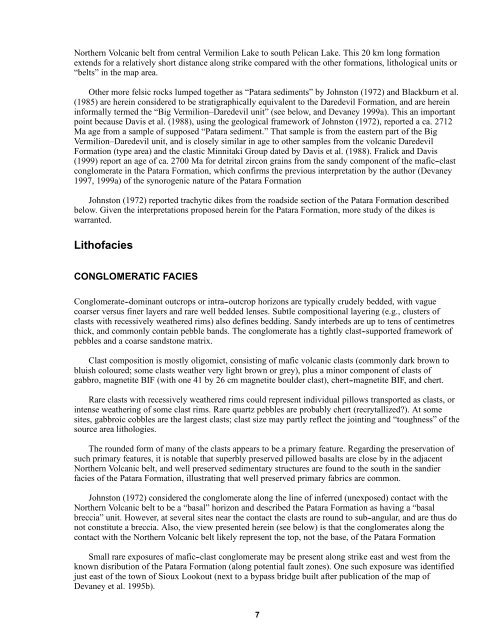Regional Geology, Sioux Lookout Orogenic Belt - Geology Ontario
Regional Geology, Sioux Lookout Orogenic Belt - Geology Ontario
Regional Geology, Sioux Lookout Orogenic Belt - Geology Ontario
Create successful ePaper yourself
Turn your PDF publications into a flip-book with our unique Google optimized e-Paper software.
Northern Volcanic belt from central Vermilion Lake to south Pelican Lake. This 20 km long formation<br />
extends for a relatively short distance along strike compared with the other formations, lithological units or<br />
“belts” in the map area.<br />
Other more felsic rocks lumped together as “Patara sediments” by Johnston (1972) and Blackburn et al.<br />
(1985) are herein considered to be stratigraphically equivalent to the Daredevil Formation, and are herein<br />
informally termed the “Big Vermilion–Daredevil unit” (see below, and Devaney 1999a). This an important<br />
point because Davis et al. (1988), using the geological framework of Johnston (1972), reported a ca. 2712<br />
Ma age from a sample of supposed “Patara sediment.” That sample is from the eastern part of the Big<br />
Vermilion–Daredevil unit, and is closely similar in age to other samples from the volcanic Daredevil<br />
Formation (type area) and the clastic Minnitaki Group dated by Davis et al. (1988). Fralick and Davis<br />
(1999) report an age of ca. 2700 Ma for detrital zircon grains from the sandy component of the mafic--clast<br />
conglomerate in the Patara Formation, which confirms the previous interpretation by the author (Devaney<br />
1997, 1999a) of the synorogenic nature of the Patara Formation<br />
Johnston (1972) reported trachytic dikes from the roadside section of the Patara Formation described<br />
below. Given the interpretations proposed herein for the Patara Formation, more study of the dikes is<br />
warranted.<br />
Lithofacies<br />
CONGLOMERATIC FACIES<br />
Conglomerate--dominant outcrops or intra--outcrop horizons are typically crudely bedded, with vague<br />
coarser versus finer layers and rare well bedded lenses. Subtle compositional layering (e.g., clusters of<br />
clasts with recessively weathered rims) also defines bedding. Sandy interbeds are up to tens of centimetres<br />
thick, and commonly contain pebble bands. The conglomerate has a tightly clast--supported framework of<br />
pebbles and a coarse sandstone matrix.<br />
Clast composition is mostly oligomict, consisting of mafic volcanic clasts (commonly dark brown to<br />
bluish coloured; some clasts weather very light brown or grey), plus a minor component of clasts of<br />
gabbro, magnetite BIF (with one 41 by 26 cm magnetite boulder clast), chert--magnetite BIF, and chert.<br />
Rare clasts with recessively weathered rims could represent individual pillows transported as clasts, or<br />
intense weathering of some clast rims. Rare quartz pebbles are probably chert (recrytallized?). At some<br />
sites, gabbroic cobbles are the largest clasts; clast size may partly reflect the jointing and “toughness” of the<br />
source area lithologies.<br />
The rounded form of many of the clasts appears to be a primary feature. Regarding the preservation of<br />
such primary features, it is notable that superbly preserved pillowed basalts are close by in the adjacent<br />
Northern Volcanic belt, and well preserved sedimentary structures are found to the south in the sandier<br />
facies of the Patara Formation, illustrating that well preserved primary fabrics are common.<br />
Johnston (1972) considered the conglomerate along the line of inferred (unexposed) contact with the<br />
Northern Volcanic belt to be a “basal” horizon and described the Patara Formation as having a “basal<br />
breccia” unit. However, at several sites near the contact the clasts are round to sub--angular, and are thus do<br />
not constitute a breccia. Also, the view presented herein (see below) is that the conglomerates along the<br />
contact with the Northern Volcanic belt likely represent the top, not the base, of the Patara Formation<br />
Small rare exposures of mafic--clast conglomerate may be present along strike east and west from the<br />
known disribution of the Patara Formation (along potential fault zones). One such exposure was identified<br />
just east of the town of <strong>Sioux</strong> <strong>Lookout</strong> (next to a bypass bridge built after publication of the map of<br />
Devaney et al. 1995b).<br />
7

















